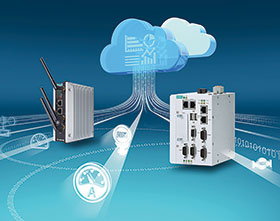

New computing methods are helping to create autonomous edge nodes that are about to change the IIoT landscape. Edge nodes are data-aggregation points in an IIoT system, where the physical world of sensors and actuators interacts with computational resources such as IIoT gateway computers. This new computing model is based on edge nodes that are enhanced with local storage and computing power, in addition to machine-learning algorithms that enable them to process data locally and make quick decisions. An intelligent edge node enables faster decisions according to local identity management and access control policies, secures data close to its source, and reduces communication costs.
Edge intelligence is edge computing fortified with machine or self-learning algorithms, advanced networking capabilities, and end-to-end security. This article discusses four key elements of a good edge intelligence solution.
1. Localised data processing
The troves of data collected at the edge of a network can quickly lose their relevance. Hence, the data should be processed and useful insights derived from it at the earliest opportunity. Mission-critical systems, such as healthcare and factory monitoring, require quality data measurements and instant decisions. In addition to being time consuming, sending data from the edge to the cloud can lead to data corruption and processed data without the required context.
For these reasons, the edge node should be equipped with the ability to process data locally and only key information should be sent to the cloud to develop data models. Edge nodes with local storage and processing capabilities keep the data closer to the source.
2. Real-time decision making at the edge
Edge intelligence enables real-time decision making at the edge nodes. Decision latency can be drastically reduced by enabling edge node analytics. Machine learning or self-learning algorithms can be developed locally or in the cloud and deployed at the edge to make the edge nodes autonomous, enabling quick decision making.
3. Robust edge-to-node communication
Data integrity is key in the edge-computing model because decisions are made at the edge node level. Data that is sensed and measured at these devices is of little use if the communication between the devices and the edge node is not consistent. No data loss or data corruption can be tolerated as the edge node is now responsible for making key process-related decisions. Other communication aspects to consider are range, bandwidth, device-to-device communication, the communication protocols to support, and how to power edge devices. A good edge network is one that is optimised for wireless sensor communication.
4. Security at the edge
The lifecycle of an IIoT system is often longer than a traditional computing system as many edge devices remain in operation even decades after they were deployed. While servers and PCs are complex enough to allow for security provisions, IIoT nodes are usually low in power consumption and processing power. Edge-intelligence solutions equip the edge node with local storage and processing power and a varied set of software and hardware options help secure the edge devices and nodes. Some of the methods used to secure the edge nodes include:
• Edge platform with end-to-end security.
• Intrusion prevention systems (IPS).
• External hardware security.
• Secure boot capability.
Since edge nodes are the gateways to the physical world, when an edge device or node is compromised it is not just data that is at risk. Cyber attackers can now potentially access unsecure edge nodes and devices to interfere with industrial processes or shut down equipment resulting in financial loss and even life-threatening situations.
For more information contact RJ Connect, +27 11 781 0777, [email protected], www.rjconnect.co.za
| Tel: | +27 11 781 0777 |
| Email: | [email protected] |
| www: | www.rjconnect.co.za |
| Articles: | More information and articles about RJ Connect |

© Technews Publishing (Pty) Ltd | All Rights Reserved